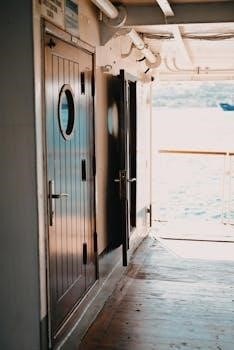Stephen Crane’s “The Open Boat”⁚ An Analysis
Stephen Crane’s “The Open Boat,” often available in PDF format online, provides a gripping narrative․ It delves into themes explored through the experiences of four men struggling for survival․
Overview of “The Open Boat”
“The Open Boat,” a short story by Stephen Crane, frequently accessed in PDF form, presents a harrowing tale of survival․ It recounts the experiences of four men—a cook, an oiler, a correspondent, and a captain—adrift at sea in a small dinghy after their ship sinks․ The narrative focuses on their struggle against the relentless and indifferent forces of nature․ The men find themselves battling exhaustion, hunger, and the constant threat of the waves as they attempt to reach the shore․
Crane masterfully depicts their physical and psychological challenges, highlighting the themes of brotherhood, the illusion of control, and nature’s indifference․ The story explores the men’s evolving relationships as they rely on each other for support and encouragement․ This short story provides a profound exploration of human bonds tested by elemental forces, a central narrative based on Crane’s own experience of surviving a shipwreck, detailing the harrowing journey․
Based on a True Story
Stephen Crane’s “The Open Boat,” often studied via PDF versions, is deeply rooted in reality․ The narrative draws heavily from Crane’s personal experience of surviving the shipwreck of the Commodore in 1897․ As a journalist, Crane was aboard the steamer when it sank off the coast of Florida․ He spent nearly 30 hours adrift in a small lifeboat with three other men before reaching land․
This real-life ordeal profoundly impacted Crane and served as the inspiration for his acclaimed short story․ The events, emotions, and observations from that experience are vividly recreated in “The Open Boat,” lending the story a sense of authenticity and immediacy․ The characters and their interactions are inspired by Crane’s fellow survivors, making the story a powerful testament to human resilience in the face of nature’s indifference․ Crane captures the raw emotions and physical challenges of survival․
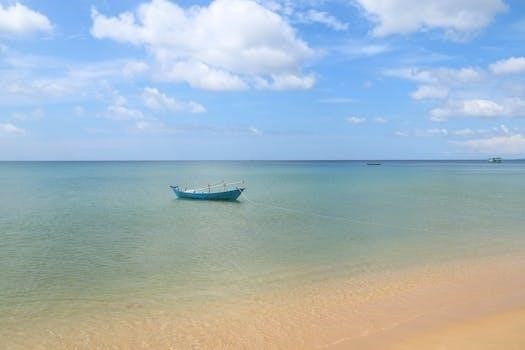
Characters and Their Roles
The PDF versions of “The Open Boat” highlight four distinct characters․ Each fulfills a specific role during their survival․ Their interdependence underscores themes of brotherhood, camaraderie, and the illusion of control․
The Correspondent
In Stephen Crane’s “The Open Boat,” often accessible in PDF form, the correspondent emerges as a central figure, grappling with existential questions amidst the struggle for survival․ Initially, the correspondent is depicted as an observer․ He is meticulously documenting the unfolding drama․ As the narrative progresses, he evolves, becoming increasingly introspective․
His role transcends mere observation․ He is a conduit for Crane’s exploration of nature’s indifference and humanity’s place within it․ The correspondent’s internal monologues, frequently highlighted in critical analyses of the story available in PDF format online, reveal a growing awareness of the universe’s vastness․
The correspondent battles nature’s power․ He questions the perceived injustice of their predicament․ His intellectual journey is a defining characteristic․ He represents the human capacity for reflection even in the face of overwhelming adversity; The correspondent provides a lens․ This lens lets the reader understand the broader philosophical themes at play in “The Open Boat․”
The Oiler (Billie)
Billie, the oiler, in Stephen Crane’s “The Open Boat,” often found in PDF versions online, embodies unwavering physical strength and tireless dedication․ He is arguably the most active character․ He continuously rows, battling the relentless waves to bring the men closer to shore․ Billie’s actions are not driven by philosophical musings but by a primal instinct to survive․
His character is a study in resilience, consistently pulling his weight, despite the dire circumstances․ Unlike the correspondent’s introspective nature, Billie remains focused on the immediate task at hand․ He is focused on keeping the boat afloat․ His tragic fate, often analyzed in detail in resources and PDFs about the story, underscores the theme of nature’s indifference․
Despite his tireless efforts and evident skill, Billie succumbs to the sea’s unforgiving power․ His death serves as a stark reminder that even the strongest and most diligent individuals are not immune to nature’s capriciousness․ Billie’s sacrifice highlights the futility of human endeavor against the backdrop of a vast, uncaring universe․
The Cook
The cook, a portly and somewhat comical figure in Stephen Crane’s “The Open Boat” (analyzed extensively in numerous PDF documents), represents a certain naive optimism amidst the dire circumstances․ He spends much of his time bailing water from the boat․ The cook’s repetitive mantra, “Gawd! That was a narrow clip,” reveals his limited understanding of the gravity of their situation․
His reliance on simple faith and his attempts to reassure the others, despite the overwhelming odds, offer a contrast to the correspondent’s growing cynicism․ The cook clings to the hope of rescue, fueled by his limited perspective․ This highlights the differing ways individuals cope with extreme stress․
While the oiler contributes physical labor, the cook provides emotional support, however naive․ His presence alleviates some of the tension․ Analyses of “The Open Boat,” often available as PDFs, explore how the cook embodies the human need for hope․ His unwavering optimism, though perhaps unrealistic, becomes a source of comfort․ He shows the desperation in the struggle;
The Captain
The captain in “The Open Boat,” a story readily available in PDF format for study, is a figure marked by injury and responsibility․ Having been hurt in the shipwreck of the Commodore, he is physically weakened, his leadership now constrained․ The captain is unable to perform the physical labor of rowing, he assumes a more strategic role․ He offers guidance and encouragement to the other men․
His stoicism, born from the burden of command, is evident throughout their ordeal․ The captain refrains from outward displays of despair․ He focuses on maintaining order and hope in the face of nature’s indifference․ He embodies a sense of duty․ Many analyses, accessible in PDF form, highlight the contrast between the captain’s inner turmoil and his calm exterior․
He feels responsibility for the men’s safety․ His quiet determination serves as a source of strength․ The captain’s leadership, though limited by his condition, exemplifies the resilience of the human spirit․ Despite the awareness of their peril, he remains committed to his duty․
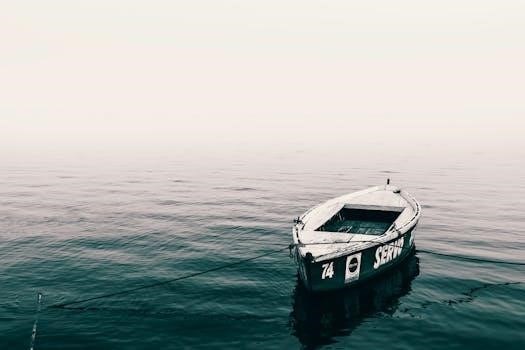
Themes in “The Open Boat”
“The Open Boat,” often studied from PDF versions, explores themes of nature’s indifference․ It also examines brotherhood, camaraderie, and the stark illusion of control in desperate circumstances․
Nature’s Indifference
Stephen Crane’s “The Open Boat,” frequently accessed via PDF, poignantly portrays nature’s stark indifference to human suffering․ The men in the dinghy are at the mercy of the waves․ The vast ocean symbolizes an uncaring universe, oblivious to their plight․ The story highlights the insignificance of human life against the backdrop of nature’s power․
This theme is crucial․ The characters face relentless waves and unpredictable weather․ This underscores the idea that nature operates without regard for human concerns․ The availability of “The Open Boat” in PDF format allows for deeper exploration․ Students and scholars can analyze how Crane uses vivid descriptions to emphasize this theme․
Ultimately, the story’s impact lies in its depiction of a world where human struggles are met with silence from the natural world․ The PDF version allows readers to closely examine the text for its poignant message․
Brotherhood and Camaraderie
Amidst nature’s indifference, “The Open Boat,” often studied through PDF versions, showcases the powerful bond of brotherhood and camaraderie․ The four men, the correspondent, the oiler, the cook, and the captain, form an unexpected alliance against the elements․ Their shared struggle fosters a sense of unity․ This helps them overcome adversity․
Despite their different backgrounds, they rely on each other for survival․ Each man contributes his strengths to the group’s collective effort․ This illustrates the importance of human connection․ The availability of “The Open Boat” in PDF allows readers to closely analyze the interactions between the characters․
Their shared experience transforms them․ They develop a deep sense of empathy for one another․ This highlights the enduring power of human connection․ The PDF facilitates a focused examination of this crucial theme․ It contributes to a deeper understanding of the story’s message․
The Illusion of Control
“The Open Boat,” frequently accessed as a PDF, masterfully portrays the illusion of control in the face of nature’s overwhelming power․ The men in the boat, despite their efforts to navigate and survive, are ultimately at the mercy of the sea․ This theme underscores humanity’s limited ability to control its destiny;
Their meticulous rowing and bailing are contrasted with the unpredictable waves and currents․ The men believe they can influence their fate, but nature remains indifferent to their struggles․ The availability of the story in PDF format allows for detailed analysis of this contrast․
The characters’ plans and strategies are often thwarted by unforeseen events․ This emphasizes the futility of their attempts to exert control․ This reinforces the narrative’s central theme․ The PDF version facilitates a careful examination of this theme․ It offers insights into the human condition․
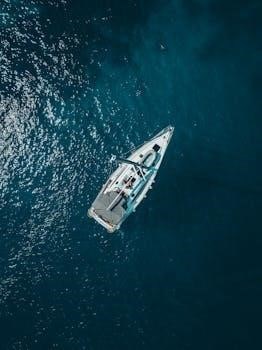
Literary Devices and Style
Analyzing “The Open Boat,” often read in PDF form, reveals Crane’s skillful use of literary devices․ His style enhances the story’s realism, emphasizing the men’s desperate struggle against nature’s indifference․
Realism and Naturalism
Stephen Crane’s “The Open Boat,” frequently accessed as a PDF, exemplifies both realism and naturalism․ The story meticulously depicts the harsh realities faced by the four men, highlighting their struggle against the indifferent forces of nature․ Crane avoids romanticizing their situation, presenting a stark and unvarnished portrayal of their ordeal․
Crane’s realism is evident in his detailed descriptions of the sea, the boat, and the men’s physical and emotional states․ He captures the nuances of their dialogue and the gradual erosion of their hope․ Naturalism is shown through the characters’ powerlessness․ The characters are at the mercy of the ocean’s unpredictable nature․
The story’s strength lies in its ability to convey the characters’ raw experiences․ Crane highlights the brutal truth of their situation․ Ultimately, the ocean cares little for the men’s survival․ This approach illustrates a naturalistic worldview, portraying humans as subject to environmental forces beyond their control․
Symbolism
“The Open Boat,” often studied via PDF versions, is rich in symbolism, enhancing its thematic depth․ The boat itself serves as a potent symbol of humanity’s fragile existence․ It is a small vessel adrift in a vast and indifferent universe․ This symbolizes the precariousness of life and the limited control individuals have over their fate․
The sea, with its relentless waves, symbolizes the overwhelming power of nature․ The waves represent the constant challenges and obstacles that the men must confront․ Furthermore, the shark that appears in the story symbolizes the ever-present threat of death and the unpredictable dangers that lurk beneath the surface of life․
Finally, the lighthouse becomes a symbol of hope and a false promise․ The men believe reaching it will bring salvation․ When they are unable to reach it, this illustrates the deceptive nature of hope and the illusion of control in an uncaring world․ The story uses symbolism to underline its themes of survival, brotherhood, and nature’s apathy․
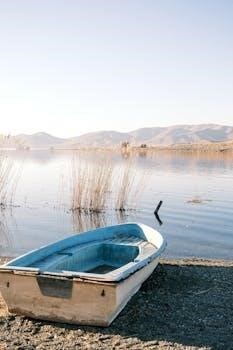
The Ending and Its Significance
The ending of Stephen Crane’s “The Open Boat,” often analyzed through readily available PDF copies, is both tragic and profound․ After enduring immense hardship, the men finally reach the shore, but not all survive․ The oiler, Billie, the strongest of the four, tragically drowns in the surf․
This unexpected death underscores the story’s central theme of nature’s indifference to human suffering․ Despite their camaraderie and valiant efforts, nature remains arbitrary and merciless․ Billie’s demise highlights the illusion of control and the ultimate powerlessness of humans against the forces of the natural world․
The survivors, the correspondent, the cook, and the captain, are left with a newfound understanding․ They recognize the vastness of the universe and their place within it․ They finally interpret the subtle voices of nature, gaining a deeper comprehension of its cold and impartial nature․ The ending leaves a lasting impact, prompting reflection on the human condition and the struggle for survival in a world devoid of inherent meaning․
